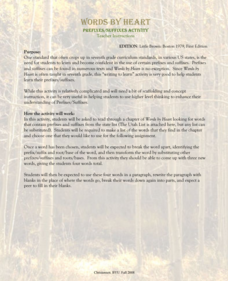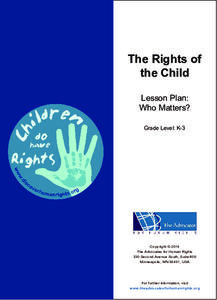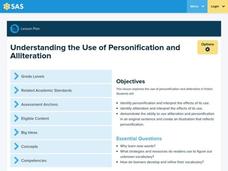Novelinks
Words by Heart: Prefixes/Suffixes Activity
This lesson is so beneficial it makes any teacher's heart skip a beat! After readers identify words from Words by Heart, they break down unknown vocabulary with a handout detailing various prefixes and suffixes. Once they finish...
Literacy Design Collaborative
Author Study: Kate Chopin
Four stories by Kate Chopin offer high schoolers an opportunity to demonstrate their understanding of the ways authors use various literary elements and movements to develop their themes and social commentaries.
Florida Center for Reading Research
Vocabulary: Word Analysis, Word-by-Word
Scholars identify word relationships, categorize words, and identify similarities and differences between word meanings.
EngageNY
Analyzing a Model Position Paper: “Changing Our Water Ways”
Follow the leader for better writing! Scholars analyze a model position paper, "Changing Our Water Ways." During the first pass, they listen as the teacher reads the paper aloud. They then do a second read of the paper and complete a...
Advocates for Human Rights
The Rights of the Child
Dr. Seuss wrote " A person's a person, no matter how small." The elementary resource uses Dr. Seuss's book Horton Hears a Who to explore children's rights in an engaging way. Young academics listen to the story, participate in group...
EngageNY
Reading for Gist: “Middle Ages” Excerpt 1
Dig deep. Scholars dig deep for meaning while reading Middle Ages Excerpt 1. They begin by finding unfamiliar words and adding them to a word catcher. Pupils then take a close look at adversity in the text and complete an anchor chart.
EngageNY
Mid-Unit Assessment: Analyzing Idea Development in Chapter 3 of World without Fish
Half way there. Scholars work on the mid unit assessment for World without Fish. Learners work independently to complete the assessment. They then answer text-dependent questions and use sticky notes for annotating.
Curated OER
Food and Languages of the World
Students explore and notice how foods from different countries of the world are alike and different. In this food and languages of the world lesson, students examine fruit and bread from a variety of countries around the world. After...
Curated OER
Foods and Languages of the World
Students create their own ice cream sundae given various toppings from around the world. In this foods and languages of the world diversity lesson, students develop an understanding of diversity in culture, family structure, ability and...
Curated OER
Food and Languages of the World
Students listen to the story "No Blue Food" in this lesson plan. They then discuss Allegra, the main character, and her hesitation to try new foods. They participate in a matching game in which they match cards to determine a fruit...
Curated OER
Foods and Languages of the World
Young scholars explore Japan. In this Japanese culture lesson, students listen to stories regarding Japan, view Japanese art, learn Japanese words, and make Origami.
Curated OER
Foods and Languages of the World
Students celebrate diversity. In this multicultural appreciation lesson, students celebrate diversity by sampling food from different cultures, learning a few words in Spanish and identifying the seven different continents.
Curated OER
That Sneaky E!!
Introduce your class to the concept of vowel digraphs. They identify the digraph /ea/ in spoken language. After a brief discussion, they apply the rule for identifying and spelling words containing the /ea/ digraph. Because the...
Water
Global Water Supply Middle School Curriculum
We take a steady shower stream and clean drinking water for granted, but in many countries around the world, the lack of water or a clean water supply is responsible for higher sickness and death rates. Taking a closer look at the water...
Curated OER
Printing and Publishing
Explore African literature and artwork in a multicultural literacy and art lesson. Begin with a read aloud of Tiger and the Big Wind: A Tale from Africa, and afterward, have kids retell the main events in the story. They identify and...
Curated OER
Review of Personification and Alliteration
Learners review personification and alliteration. In this literary devices lesson, students use personification and alliteration in a sentence. Learners draw a picture reflecting personification.
Curated OER
Sense Poetry
Access your young poets' senses and emotions with this activity, which guides them through the process of writing a "sense poem." After working on a sense poem as a class and modeling the procedure, individuals work on their own poems...
Manchester University
Alliteration
Kids create cool clauses selecting a single starting sound. Ah, alliteration.
English Club
Prefixes
The power of prefixes to change the meaning of words becomes clear to intermediate-level English language learners with a two-page worksheet. Individuals select a prefix from a provided list to alter words to match the meaning of...
Curated OER
Reaching English Language Learners Through Cooperative Learning
Students in ESL, ELL take part in small groups according to their language proficiency skills and to determine how to problem solve with a language barrier.
Curated OER
Language Arts: Fluency and Comprehension
Students increase fluency through repeated reading exercises. In groups, they practice reading sentences prior to reading the book, "Jane and Bob." Individually, students read parts to the teacher who notes expression, smoothness, and...
Curated OER
Spelling List 3: Sight Words, "-aw" Pattern, and Academic Vocabulary
In this spelling worksheet, learners copy 16 words 2 times each. Words are either sight words, academic vocabulary or have the -aw pattern.
Curated OER
Language Arts: Final Drafting
High schoolers are able to revise their own essays for greater clarity and fluency, adding explanation where needed and cutting extraneous information where appropriate. They are able to compose an academic essay with a complete...
Curated OER
Spelling List 34: Sight Words, Greek Root "ann/enn," and Academic Vocabulary
In this spelling worksheet, students copy a set of spelling words two times each. Words focus on sight words, Greek roots "ann"/"enn" and academic vocabulary.

























